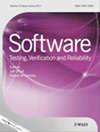Working Across Boundaries
IF 1.2
4区 计算机科学
Q3 COMPUTER SCIENCE, SOFTWARE ENGINEERING
引用次数: 0
Abstract
This editorial was written during a period of extreme difficulty for many individuals, families, and nations in the ongoing COVID-19 outbreak. We can only hope that measures taken are successful and that the situation has improved considerably. We also do not pretend that we have anything to add regarding health, social, or economic issues. However, the crisis has shown the role that Computer Science can play in informing policy. Society requires evidence and computers are often involved in producing such evidence via, for example, simulation. It is here that we, as a community, can contribute through advances in testing, verification, and reliability in areas such as Scientific Computing and Computer Simulations and maybe also AI/data sciences for helping expedite the process of finding treatment. As a recent example discussed in social media, when commenting on pandemic simulation code used to model control measures against COVID-19, Prof. Guido Salvaneschi said in his tweet: “Ever wondered about the “impact“ of research on programming languages and software engineering? Political decisions affecting hundreds of millions are being taken based on thousands of lines of 13+ years old C code that allegedly nobody understands anymore. #COVID19 #cs” (https://twitter.com/guidosalva/status/1242049884347412482). There is already some truly excellent work for making advances in these areas and we are confident that the community will rise to the challenge. This issue contains two papers. In the first paper, Simons and Lefticaru introduce a new Model-Based Testing approach, which is based on the use of a Stream X-machine (SXM) specification. SXMs provide a state-based formalism and there is a traditional approach to testing from an SXM. This approach typically assumes that the underlying functions/operations have been implemented correctly but these functions may be integrated (into a state machine) in the wrong way. There are a number of automated test generation approaches for SXMs and the authors make two main additional contributions to this area. First, they introduce a number of novel optimisations into test generation. Second, they observe that SXM test generation algorithms return abstract test cases (sequences of functions); the paper shows how corresponding concrete test data can be generated. The approach has been implemented and evaluated on case studies, with the tool also checking that a specification satisfies certain desirable properties. (Recommended by Hyunsook Do). In the second paper, Pouria Derakhshanfar, Xavier Devroey, Gilles Perrouin, Andy Zaidman, and Arie van Deursen introduce behavioural model seeding, a new seeding approach for learning class usages from both the system source code under test and existing test cases. The learned class usages are represented in a state-machine-based behavioural model. The behavioural model is then used to guide search-based crash reproduction, which generates a test case (i.e., objects and sequences of method calls on those objects) to reproduce a crash given its stack trace. This approach is in contrast to the existing seeding strategies, which simply collect and reuse values and object states from the system source code under test and existing test cases without any abstraction. The approach has been implemented in an open-source implementation named the BOTSING toolset and evaluated on 122 crashes from six open-source applications. (Recommended by Phil McMinn).跨界工作
这篇社论是在许多个人、家庭和国家在当前的COVID-19疫情中面临极端困难时期撰写的。我们只能希望所采取的措施是成功的,局势已大为改善。我们也不会假装我们对健康、社会或经济问题有任何补充。然而,这场危机显示了计算机科学在为政策提供信息方面可以发挥的作用。社会需要证据,而计算机经常通过模拟等方式参与生成证据。正是在这里,我们作为一个社区,可以通过在科学计算和计算机模拟等领域的测试、验证和可靠性方面的进步做出贡献,也许还可以通过人工智能/数据科学来帮助加快寻找治疗方法的过程。最近在社交媒体上讨论的一个例子是,Guido Salvaneschi教授在评论用于模拟COVID-19控制措施的大流行模拟代码时,在他的推文中说:“有没有想过研究对编程语言和软件工程的‘影响’?影响数亿人的政治决策是基于数千行13年以上的C代码做出的,据说没有人能理解这些代码了。# covid - 19 #cs”(https://twitter.com/guidosalva/status/1242049884347412482)。在这些领域已经有一些真正出色的工作取得进展,我们相信社区将迎接挑战。这一期有两篇论文。在第一篇论文中,Simons和Lefticaru介绍了一种新的基于模型的测试方法,该方法基于Stream X-machine (SXM)规范的使用。SXM提供了一种基于状态的形式,并且有一种从SXM进行测试的传统方法。这种方法通常假设底层功能/操作已经正确实现,但是这些功能可能以错误的方式集成(到状态机中)。有许多用于SXMs的自动化测试生成方法,作者对该领域做出了两个主要的额外贡献。首先,他们在测试生成中引入了许多新的优化。其次,他们观察到SXM测试生成算法返回抽象测试用例(函数序列);本文介绍了如何生成相应的混凝土试验数据。该方法已经在案例研究中实现和评估,该工具还检查规范是否满足某些期望的属性。(推荐:杜贤淑)在第二篇论文中,Pouria Derakhshanfar、Xavier Devroey、Gilles Perrouin、Andy Zaidman和Arie van Deursen介绍了行为模型播种,这是一种新的播种方法,用于从被测试的系统源代码和现有测试用例中学习类用法。学习到的类用法在基于状态机的行为模型中表示。然后使用行为模型来指导基于搜索的崩溃再现,它生成一个测试用例(即,对象和对这些对象的方法调用序列)来再现给定堆栈跟踪的崩溃。这种方法与现有的播种策略相反,后者只是从测试中的系统源代码和现有的测试用例中收集和重用值和对象状态,而没有任何抽象。该方法已经在一个名为BOTSING工具集的开源实现中实现,并对来自六个开源应用程序的122次崩溃进行了评估。(菲尔·麦克明推荐)。
本文章由计算机程序翻译,如有差异,请以英文原文为准。
求助全文
约1分钟内获得全文
求助全文
来源期刊

Software Testing Verification & Reliability
工程技术-计算机:软件工程
CiteScore
3.70
自引率
0.00%
发文量
34
审稿时长
>12 weeks
期刊介绍:
The journal is the premier outlet for research results on the subjects of testing, verification and reliability. Readers will find useful research on issues pertaining to building better software and evaluating it.
The journal is unique in its emphasis on theoretical foundations and applications to real-world software development. The balance of theory, empirical work, and practical applications provide readers with better techniques for testing, verifying and improving the reliability of software.
The journal targets researchers, practitioners, educators and students that have a vested interest in results generated by high-quality testing, verification and reliability modeling and evaluation of software. Topics of special interest include, but are not limited to:
-New criteria for software testing and verification
-Application of existing software testing and verification techniques to new types of software, including web applications, web services, embedded software, aspect-oriented software, and software architectures
-Model based testing
-Formal verification techniques such as model-checking
-Comparison of testing and verification techniques
-Measurement of and metrics for testing, verification and reliability
-Industrial experience with cutting edge techniques
-Descriptions and evaluations of commercial and open-source software testing tools
-Reliability modeling, measurement and application
-Testing and verification of software security
-Automated test data generation
-Process issues and methods
-Non-functional testing
 求助内容:
求助内容: 应助结果提醒方式:
应助结果提醒方式:


